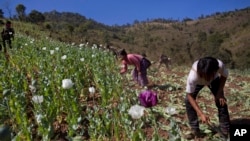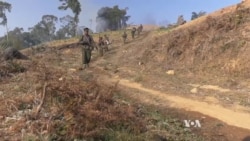The fighting that broke out in early February in Kokang, a part of northeastern Myanmar’s Shan State, has displaced tens of thousands of people, many of whom have spilled across the border into China.
While officials in Beijing and Naypyidaw say the situation is under control, clashes that started in remote jungle could spread if other rebel groups join in.
The heart of the dispute is over who controls an area bordering China that has a long history in the region’s lucrative opium trade. The government of Myanmar, which is also known as Burma, and various drug warlords, some backed by Chinese groups, have battled over the region for decades, and the latest fighting is viewed as a resumption of this old struggle for control.
But with very few reporters in the conflict zone in northern Shan State, it is difficult to verify what is happening on the ground.
In recent weeks, a videographer for VOA reached areas near the rural combat zone, embedded with one small rebel faction that has allied with the ethnic Chinese fighters against the Myanmar army.
Which side profits from opium?
In Kokang, the issue over who profits from the opium trade remains a matter of dispute. Both rebel groups and the government accuse the other side of trafficking.
Many local ethnic Palaung villagers say they want out of the business, partly because of the ruinous impact of opium in their communities and partly because the drug gangs that control the trade have made it much less profitable to grow.
The United Nations says Shan State recorded a surge of opium growing in recent years, while it was at least partly under the control of government allied factions, although there was a drop in 2014.
The ethnic Chinese rebels in Kokang have a long history of drug trafficking, and the U.S. Drug Enforcement Agency (DEA) identified their senior leader, Peng Jiasheng, as a “major trafficker” in the region in 1975.
But the rebels say they now oppose the trade, and the Ta’ang National Liberation Army (TNLA) fighters are actively working with ethnic Palaung villagers to eradicate poppy -- even while fighting continues nearby.
Longtime Myanmar analyst Bertil Lintner said some rebel groups are being pragmatic when deciding to align with rebels who have a history of trafficking.
“They (TNLA) probably see the Kokang rebels as the lesser of two evils,” he said. “The government and militias are running most of the [drug] trade up there are more of an enemy than the rebels of Kokang as far as the Palaung are concerned.”
Will Kokang fighting spread?
The fight against the government is not only over the drug trade. Rebel leaders say their grievances against the army are broadly representative of similar struggles in parts of Myanmar over autonomy that resonate with other ethnic groups.
Tar Win Maw, a senior leader with the TNLA, said many ethnic groups have been marginalized by the Myanmar government.
“The most important thing is we are all ethnic minorities and we have similar problems,” he said. “If we're not united politically and socially the Myanmar government will slowly break us apart.”
Lintner said it’s too early to tell if other groups could join the fight, broadening the conflict. But the fighting points to the failure of the government’s strategy in pushing for a nation-wide cease-fire.
“[The ethnic armies] are not interested in a cease-fire per se. They want to have a different kind of Burma. They want to have a federal union with autonomy, a local self-government for the respective ethnic areas in the country,” he said.
Years of talks involving the government and ethnic groups have failed to finalize a long-anticipated National Ceasefire Accord. Since last September, when the previous round of talks fell apart, the groups have been unable to agree on a date for resuming them.









